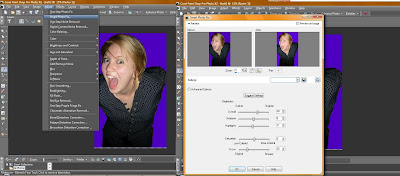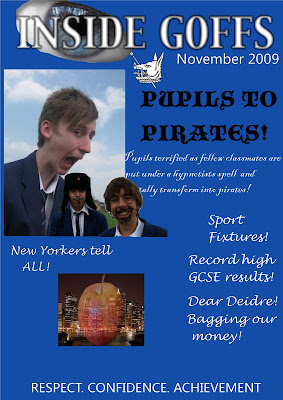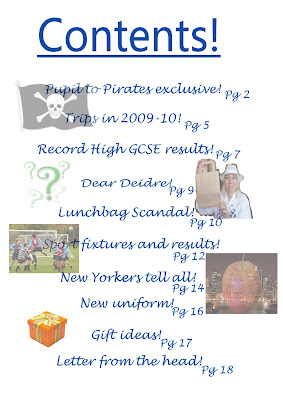


















Ideas two: Contents is once again in large font in the top right hand corner. There is one large image taking up a large percentage of the room. The image placed inside this box is still to be decided, in relation to the front cover, which is a mid-shot image I can’t repeat the same shot in the contents this doesn’t provide much variety. Showing little capability of taking various shots. Therefore the shot will be either a log shot or a close up, either those two or a mid-shot of a band. Down the right hand side of the page there are subheadings such as ‘news’ and ‘gigs’ listing the articles in numerical order in the order they appear in the magazine. This is easier for the reader to turn to the categories they are attracted to. Along the bottom of the page there will be an offer on music merchandise, next to the offer there will be a box for the reader to subscribe to the magazine for an ideal cheaper price as it is the first of ever issue of the magazine.

First idea: Contents in large font on the top right hand corner. Issue number under the contents heading. There are 3 images going diagonally down the page starting in the left hand corner. One of the images will be an image of one of the posters that’s inside. One smaller image between 2 larger images. To keep with the messy teenager concept there will be headings scattered all over the page, with articles listed underneath them. Headings consist of ‘News’, ‘Reviews’, ‘Gigs’, ;Interviews’, ‘Who’s New’, ‘ Win, Win, Win’ and ‘Quizzes’. Depending on the chosen front cover idea depends on what the colour scheme the contents page will be.

IDEAS 3: This idea is similar to the first idea.
Masthead: ME (Musical Evolution) the name centre on each individual, making them selves’ feel more important an boosts self-esteem. It’s similar to the NME style acronym, which may confuse readers. The style of music will be similar so disappoint may come from dedicated NME readers who may feel this new magazine is trying to over ride the existing mag. It represents my audiences taste in music. Just like the letter from the editor in Kerrang! It personalizes the magazine.
IMAGE: Will be a mid-shot of my model, wearing dark eyeliner and red lipsticks they contrast each other well. Depending on the pose chosen the colour of lipstick maybe dulled down a little so the eyes grab more attention she will have messy hair representing the rocker image. Also she will be wearing a deep plunge line top revealing her cleavage.
COLOUR SCHEME: Black and green. The first band I think of with the colour black and green are GreenDay. Black is a basis colour it contrasts well with any other colour it symbolises style, power and sophistication. Green represents growth and being new or in experienced which is ideal for the content of promoting up- coming bands. Also represents youth and good luck. These colours are good to use as they do contrast well, they are striking and eye catching.
DESIGN: The masthead will be ME! And be in the centre of the top of the cover. For a new magazine I want my readers to familiarise with the company before following other existing magazines and cover some of the masthead with an image. There will be one main image taking up 70% of the cover slightly off centre, more to the right. The image will be on a background from London, such as Camden Market, it’s an exciting location. Along the left hand side will be neat line up of boxes alternating colours green and black. Each pug will contain something that will feature inside the magazine. They will include main articles as well as sub articles along with a few pictures. There will be a ‘NEW!’ in the top left hand corner to show the audience it’s a new magazine. As well as ‘Issue NO. 1 and the date.
LANGUAGE: Just like the other magazine ideas, the language is going to involve a slight bit of simple slang to show the audience that the magazine is current and up to date with the times. Which will appeal to the audience, it will not be patronising or incredibly grammatically correct, as I feel that this detracts from the over all image of ‘Rock n Roll’.
I like this idea for my front cover, it will be easy to create the predominant image. The style with the neat boxes does not reflect my target audience of being messy teenagers.
IDEAS TWO: Masthead Alternate, this suggests that you deviate from normal society and change things up or you don’t follow the crowd. This is ideal for my audience, however more people listen to rock and alternative music than a few years ago, this especially for punk music.
Once again the masthead will be along the top of the magazine, following the conventions of other magazines.
IMAGE: A selection/collage of pictures of artists featured inside the magazine and magazines to come. I think this is a good way to kick off a new magazine and demonstrates the genres of music present. The cover would have artists in boxes instead of cutting round each person and overlaying each other.
COLOUR SCHEME: Red and blue these colours will be along the masthead and alternating font colours, this sticks with the masthead of alternating. A few of the boxes will be highlighted with either red or blue just to emphasize the colour scheme. The red represents danger and passion where as the blue contradicts this as it is a cool calming colour. Making the overall colour scheme neutral.
DESIGN: however this design will be mainly of the background image with few bits of texts. The text used will be in matching boxes to the images and writing across a few images, so the image is clearly visible. Little text will be used to give the image the full effect of variety. I don’t want to overpower the cover by putting too much into it.
LANGUAGE: The language is going to involve a slight bit of simple slang to show the audience that the magazine is current and up to date with the times. Which will appeal to the audience, it will not be patronising or incredibly politically correct, as I feel that this detracts from the over all image of ‘Rock n Roll’.
I feel this is a good idea, however as the criteria lists you have to take your own pictures it will be very difficult to take a large amount of different pictures, around twenty. So I don’t think I will be using this design.

MASTHEAD: My first idea for my masthead is Launch, this is because its eye catching and you can emphasize the name. According to the dictionary it is said to be used to set something off for the first time to the public ‘launch the new perfume’ but in this case it would be to launch a new band, as a large proportion of the magazine will be filled with undiscovered bands trying to break into the market. Following conventions of other mainstream, or in fact nearly every magazine the masthead will be along the top of the magazine. This position has been used for a long time. When on the shelves the top of the magazine is always visible on the racks, drawing peoples attention.
IMAGE: A friend covered in eyeliner, quite pale skin, simple lip-gloss so doesn’t take attention away from her eyes which will be looking deep into the camera in a trance sort of pose with lips pressed together, or bright red lipstick as its st
riking a passionate colour also represents danger, which can connote it’s dangerous to think you have a chance with her, or she’s drawn to danger which makes her more appealing to those rockers who ‘live on the edge’. Her outfit is undecided at the moment but it will be kept simple with dark colours keeping to the rock image, as well as being a sexy colour, its dark and mysterious. Which makes the reader be intrigued to who this girl is, I’m using a girl model as my magazine targets both the male and female audience, it’s appealing to see a sexy girl on the cover of a magazine which consists of there favourite music. Also girls can aspire to look similar, with tips on how to look like a rocker and money off eyeliner. It will either be a close up or a midshot where you can see part of her outfit.
COLUR SCHEME: One initial idea for my colours is black and purple. However now looking at the predominant image I’ve decided that the purple and red colours would clash and subtract attention from the models lips, also however if I decide to go with simple lip gloss I would choose the purple. Black and purple contrast well. Also I’m going to add green to the colour scheme, this will make it more boyish as the purple was quite overwhelming, green it’s easy on the eye and represents growth and being new or in experienced which is ideal for the content of promoting up- coming bands.
DESIGN:
Masthead along the top, posters down side, image 70% of page centre, pugs in different shaped boxes scattered around, not in a simple order down a particular side of the posters down the left hand side. 3 fit nicely and are not stretched like they cover, as the main age range of my magazine tend to be un tidy and a bit every where. Three would be if only 2 posters were available. ‘NEW’ will be in the top right hand corner along with the price as it catches your eye and reveals it’s new and affordable. The price is between £1- £2 as this is the price my questionnaire results conjured up.
LANGUAGE: The language is going to involve a slight bit of simple slang to show the audience that the magazine is current and up to date with the times. Which will appeal to the audience, it will not be patronising or incredibly grammatically correct, as I feel that this detracts from the over all image of ‘Rock n Roll’.
I like this idea it’s a catchy masthead. I think it will appeal to both audiences, however my second questionnaire will clarify if they think so. I might have to cut back a bit on the amount of purple used or use different shades to appeal to the male audience.
 I can use a close up, this obviously expresses emotion, in this particular shot you can express a genre by make up, such as dark eyeliner, for a rock look or a lot of bronzer and mascara for a RnB look.
I can use a close up, this obviously expresses emotion, in this particular shot you can express a genre by make up, such as dark eyeliner, for a rock look or a lot of bronzer and mascara for a RnB look.
Questionnaire.
1. Are you male/ female?
2. How old are you? ………..
3. Occupation…….
4. Do you read magazines often?
Yes/ No/ Sometimes.
5. How often do you buy magazines?
Once a week/ twice a week/once every two weeks/once a month/ other, please state……..
6. What draws your attention to a new magazine? (you can circle more than one)
Familiarity of the magazine/ reputation of magazine/ Masthead/ Celebrities/ freebies.
7. How much are you willing to pay for a magazine?
Less than £1/ £1- £2/ £2- £3/ more
8. What music do you prefer to listen to? (you can circle more than one)
rock/ metal/ punk/ indie/ pop/ RnB/ Dance/ Garage/oldies/ other please state……
9. Would you prefer a music magazine based on..
One type of genre/ mixture of 1 or 2 genres/ complete mixture
10. What puts you off buying a magazine? ………
11. What features do you prefer in a magazine?
Artist’s inside/Reviews/ Posters/ Quizzes/ News/ other please state……
12. Which layout do you prefer? (please circle)

Close up/ extreme close up/ mid shot/ long shot/ mid-long shot
14. Which colour scheme do you prefer?
Black and white/ Purple and black/ Purple and green/ Black and green/ other please state…..
15. Which masthead (title) do you prefer?
Alternate/ Launch/ME (music evolution)/other please state…..
I didn't include my own ideas in this first questionnaire simply because I wanted to see what they thought about existing magazines before I publish any initial ideas for my own. I have collected back the data and from the results I will hand out a second questionnaire with my ideas on.

This is Tom Whitehall, he is 17 years old, and lives in the town of Slough, just outside London. He lives with his parents and two brothers n a four-bedroom house. He attends his schools sixth form, where he studies Psychology, Music, Media and History.
He dresses fairly straight forwardly - usually jeans sometimes skinny jeans, pair of Vans a printed top and large hoody.
He usually shops at Topman, in Camden Market. He also shops a lot online on websites such as Rockabillia.com and loudclothing.com.
He enjoys listening to a variety of music. Such as Bullet For My Valentine, Disturbed, Godsmack, Linkin Park, Avenged Sevenfold. He’s also into Dance and Trance music. He downloads these but also often buys them on CD. He also likes to attend festivals such as Reading festival, Leeds Festival, Glastonbury. Favourite radio stations are Kerrang, Xfm and Scuzz.
He also enjoys watching TV programes like Family Guy, South Park, Miami Ink, LA ink, Futurama Scrubs, Two and a half men. Plus music channels, Kerrang, MTV. Along with watching films, he likes horrors, thrillers action and comedies.
I think my magazine would appeal to Tom because it will consist of the same music genre, including Linkin Park and Bullet For My Valentine. It will display up coming events, gigs and festivals. Also include pages on tattoos, and game reviews.
My magazine will target the both genders male and female, there will be aspects for both sexes, such as gaming insights for the guys and tips on how to get the rock chick look for the girls. As well as features such as reviews, interviews, news and upcoming bands and festivals for both to enjoy.
Looking at Maslow’s hierarchy of needs you can clearly see the things in life that are needed for basic survival these are referred to as physiological to self-actualization such as acceptation of fact. This along with the Uses and Gratification model and Demographics show who to target media products such as magazines at.
Maslow's Hierarchy of Needs states that we must satisfy each need in turn, starting with the first, which deals with the most obvious needs for survival itself.
Only when the lower order needs of physical and emotional well-being are satisfied are we concerned with the higher order needs of influence and personal development.
Conversely, if the things that satisfy our lower order needs are swept away, we are no longer concerned about the maintenance of our higher order needs.In turn this means that media is higher on the hierarchy as it is not a basic need, thought some may feel it is.
Uses and Gratification look at ‘Why’ people use media rather than content. The mass media compete with other sources of gratification, but gratifications can be obtained from a medium's content (e.g. watching a specific programme), from familiarity with a genre within the medium (e.g. watching soap operas), from general exposure to the medium (e.g. watching TV), and from the social context in which it is used (e.g. watching TV with the family).
A
Upper middle class
Higher managerial, administrative or professional.
Intermediate managerial, administrative or professional
Supervisory or clerical and junior managerial, administrative or professional
Skilled manual workers
Semi and unskilled manual workers
E
Those at the lowest levels of subsistence
Casual or lowest grade workers, pensioners and others who depend on the welfare state for their income
The NRS Social Grades, (National Readership Survey) class every occupation under one of these 6 categories.
Aswell as the occupation wages are taken into consideration. Therefore this model is key to analyse your potential target audience.
My ideas.
My target audience will be aimed at social grade E, students. This is because this age range tends to be more up to date with new releases of music. This is a key element for my magazine, as it will be consisting of new and upcoming music.
An idea of a genre of my particular magazine will be a mix between rock and metal, with some alternative bands inside. In which case I will have to be up to date with new releases. Popular and unknown bands to boost knowledge and understanding in the music industry, in turn boosting careers. My magazine will be one new band’s come to help publicise them